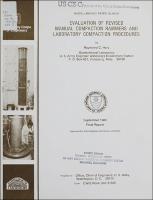Please use this identifier to cite or link to this item:
https://hdl.handle.net/11681/10362| Title: | Evaluation of revised manual compaction rammers and laboratory compaction procedures |
| Authors: | Horz, Raymond C. |
| Keywords: | Soil compaction Equipment Hand tampers Soils Soil tests Soil stabilization Procedures |
| Publisher: | Geotechnical Laboratory (U.S.) Engineer Research and Development Center (U.S.) |
| Series/Report no.: | Miscellaneous paper (U.S. Army Engineer Waterways Experiment Station) ; GL-83-20. |
| Description: | Miscellaneous Paper Abstract: The U.S. Army Corps of Engineers currently specifies sliding weight-type rammers for laboratory compaction tests rather than sleeve-type rammers as required by the American Society for Testing and Materials (ASTM), the American Association of State Highway and Transportation Officials (AASHTO), and other organizations. This study compares 10-lb sliding weight rammers with the 10-lb ASTM sleeve rammer and compares newly designed 5.5-lb and 10-lb sliding weight rammers with low mass spring-loaded feet with the corresponding ASTM rammers. Five soils were used, ranging from a nonplastic silty sand to a fat clay. The effects of (A.) rate of operation of the rammers, (B.) air-drying and curing the soil prior to compaction results, (C.) use of a sector-shaped foot on compaction and California bearing ratio (CBR) results were investigated. Finally, various methods of calibrating mechanical compactors were investigated. Conclusions were : (1.) the 10-lb sliding weight rammers currently used by the Corps of Engineers gave maximum dry densities as much as 3.0 pcf lower, and optimum water contents as much as 1.7 percent higher than the ASTM rammer; (2.) the new sliding weight rammers (both 5.5- lb and 10-lb) produced maximum dry densities less than 1 pcf lower and optimum water contents less than 1 percent higher than those produced by the ASTM rammers; (3.) dry density increases with increasing rate-of-blow application for both sleeve- and sliding-weight type rammers, but the magnitude of this increase varies from operator to operator; (4.) there were significant effects due to air drying a fat clay prior to compaction, even when a curing period was allowed; (5.) using a mechanical rammer with a sector-shaped foot to compact soil in the 6-in. mold produced the same overall compaction results but CBR values as much as 44 percent lower at optimum water content than the CBR values produced by a manual sleeve rammer; and (6.) calibration of mechanical rammers by compacting soil and by deforming lead test cylinders gave good results. Guidance is given for determining the number of trials required to obtain reliable results when using lead cylinders. |
| Rights: | Approved for public release; distribution is unlimited. |
| URI: | http://hdl.handle.net/11681/10362 |
| Appears in Collections: | Miscellaneous Paper |
Files in This Item:
| File | Description | Size | Format | |
|---|---|---|---|---|
| MP-GL-83-20.pdf | 16.06 MB | Adobe PDF |  View/Open |